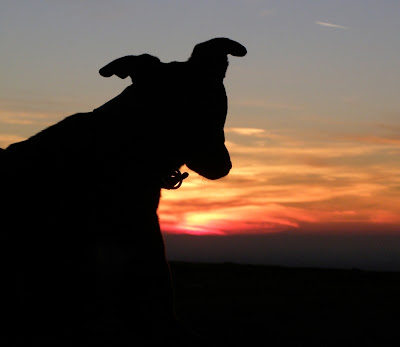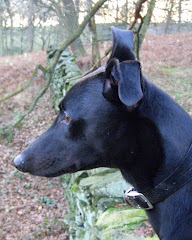Friday 29 February 2008
Weather Views
Thursday 28 February 2008
Lonesome Tree
Wednesday 27 February 2008
Tuesday 26 February 2008
Gate Post Marker
 The arrow mark on this gate post bares the mark of the War Department Arrow.. I come across these quite often when out and about. This one was high up on a moorland road so maybe it was meant to point towards a shooting range or a look-out post. It is interesting to see them and think about who made these marks and who followed them.
The arrow mark on this gate post bares the mark of the War Department Arrow.. I come across these quite often when out and about. This one was high up on a moorland road so maybe it was meant to point towards a shooting range or a look-out post. It is interesting to see them and think about who made these marks and who followed them.Monday 25 February 2008
Earwig Beetle

Earwigs vary in size from 1/2-1" in length, they are brown to black in color. Species may be winged or wingless. Only a few species are good fliers. The body terminates in a pair of forceps. These forceps or pincers are the earwig's most distinctive characteristic. The forceps are used in capturing prey and mating. Earwigs are omnivorous, feeding on a variety of food. They will eat live or dead insects as well as live or decaying vegetation.
Earwigs are nocturnal. During the day they will be found in moist shady places, under wood piles, stones, boards, compost piles, flower beds, and other secluded locations. When earwigs migrate indoors, they hide in cracks and crevices around the floor and other locations. They may be found in potted plants and cut flowers
Sunday 24 February 2008
Lee and Burning The heather
Now you might be forgiven for thinking that Lee is a bit of a firebug.. but he's not.. burning the Heather is an important job. In Scotland, heather burning is referred to as Muirburn and in the south-west of England it is called Swaling but it means the same.
On a lighter note, Tom's misses Jane is first in the queue when it comes to having your very own Lady Chatterley's Lover. Jane said he dose not need those flames behind him to look hot.... ha! what Lee should be worried about is that Tom agreed.. ha!.
Saturday 23 February 2008
Friday 22 February 2008
Thursday 21 February 2008
Wednesday 20 February 2008
Stalked & Shot
One of the tools of the trade, a trusty Land Rover. Notice the rail above the cab, and the lamp. These would be put to good use when out at night culling the local fox population. Look at that snow as well... I would think that Lee and men like him are out in all weathers doing this job. They will be working from dawn till dusk at this time of the year, and then out at night again lamping. Then in the early hours the phone might ring and someone as spotted a poacher, he can't just rollover and deal with it in the morning.. I should think Lee and others like him certainly earn their corn.
Tuesday 19 February 2008
Mountain Hare Cull

Highlands. Moorland environments provide a perfect habitat with an abundance of short, pioneer heather for feeding, and longer more mature heather for shelter and protection from predators. Highest densities of mountain hares are found on moors managed for grouse where the burning produces different aged stands of heather ideal for both hares and grouse.
The diet of mountain hare is variable depending on the available vegetation. If possible the Hares will feed on grasses during the summer and switch to a heather-dominated diet during winter. Other vegetation that features in their diet are rushes, sedges, blueberry, gorse, the bark and low twigs from trees.
The mountain hare is not a managed game species, but at times large numbers are shot. Lee tells me this cull was needed as the hares were doing so well on the local moors he managers and numbers had swelled in the last two seasons. This amount might seem large until you think of the acreage involved. A mountain Hare can also eat a third in a day of what a moorland sheep can. More from Lee the Game Keeper tomorrow.
Monday 18 February 2008
Game Keeper Lee


From an early age Lee was interest in nature and wildlife, when the chance came to follow up this interest he jumped at the chance and I don't think he as looked back since.


These are some of the views Lee sees one a daily basis while going about his job as a game keeper . To many, a Gamekeeper is someone who is an indiscriminate destroyer of wildlife, providing sport for a privileged few. In fact the case of the modern gamekeeper, could be not be further from the truth. Lee grew up with a great knowledge of nature and wildlife and now he living the dream. I have a few pictures to show which Lee as kindly sent me... some do show the outcome of a hunt/cull but I'll post them again with an explanation of the whys and whyfors.
Sunday 17 February 2008
Saturday 16 February 2008
A Liking To Lichen


Friday 15 February 2008
Thursday 14 February 2008
Wednesday 13 February 2008
Edale To Crowden No.3
 In the distance you can see the smoke from 'Burning The heather, burning removes the dead material and recycles the nutrients. This encourages fresh new growth to sprout from existing heather plants. Burning maintains heather moorland and prevents natural succession, which would otherwise result in growth of scrub and birch woodland. The burning cycle creates a pattern of different aged heather. The oldest provides cover for birds like the Red Grouse ( seen below ) and the new shoots provide succulent food for other birds and sheep. A well-burnt moorland will have a mosaic of heather and other moorland plants of differing ages, which will provide food for different wildlife. Heather burning is a very old way of controlling and prolonging the life cycle of the heather.
In the distance you can see the smoke from 'Burning The heather, burning removes the dead material and recycles the nutrients. This encourages fresh new growth to sprout from existing heather plants. Burning maintains heather moorland and prevents natural succession, which would otherwise result in growth of scrub and birch woodland. The burning cycle creates a pattern of different aged heather. The oldest provides cover for birds like the Red Grouse ( seen below ) and the new shoots provide succulent food for other birds and sheep. A well-burnt moorland will have a mosaic of heather and other moorland plants of differing ages, which will provide food for different wildlife. Heather burning is a very old way of controlling and prolonging the life cycle of the heather. This is our Skylark..it larger than a sparrow but smaller than a starling. It is streaky brown with a small crest which can be raised when the bird is excited or alarmed It as a white-sided tail and the wings also have a white rear edge which can be seen in flight. It is renowned for its display flight, vertically up in the air. you can normally here the Song but the bird flying high can be hard to spot.
This is our Skylark..it larger than a sparrow but smaller than a starling. It is streaky brown with a small crest which can be raised when the bird is excited or alarmed It as a white-sided tail and the wings also have a white rear edge which can be seen in flight. It is renowned for its display flight, vertically up in the air. you can normally here the Song but the bird flying high can be hard to spot.
 Our native Mountain or Blue hare is smaller than the introduced brown hare, it as a more rounded shape and without a black upper surface on the tail. Mountain hares also have shorter ears and legs than the brown hare. In summer, they have grey/black coats, and in winter they are partly, or completely white as the two above. These moult twice a year - in late autumn, and again in the spring when they lose their winter coat.
Our native Mountain or Blue hare is smaller than the introduced brown hare, it as a more rounded shape and without a black upper surface on the tail. Mountain hares also have shorter ears and legs than the brown hare. In summer, they have grey/black coats, and in winter they are partly, or completely white as the two above. These moult twice a year - in late autumn, and again in the spring when they lose their winter coat. The red grouse is a medium-sized game bird. It has a plump body with a short tail and a tiny hook tipped bill. It is reddish-brown, its legs and feet are covered in pale feathers. These birds breed in the moorlands and are resident all year round. The best place to see this bird is on upland heather moors, when it suddenly rockets up from the heather when disturbed to fly off with fast-whirring wingbeats.
The red grouse is a medium-sized game bird. It has a plump body with a short tail and a tiny hook tipped bill. It is reddish-brown, its legs and feet are covered in pale feathers. These birds breed in the moorlands and are resident all year round. The best place to see this bird is on upland heather moors, when it suddenly rockets up from the heather when disturbed to fly off with fast-whirring wingbeats.
Tuesday 12 February 2008
Edale To Crowden No.2
 Peter as not done all of this route yet, but plans are being made for him and others to do it this year.
Peter as not done all of this route yet, but plans are being made for him and others to do it this year.  It's a 270-mile walk that will take him from the Peak District National Park in Derbyshire along the Pennine ridge through to the Yorkshire Dales, up into Northumberland, and then across the Cheviots, setting him down in the Scottish Borders..
It's a 270-mile walk that will take him from the Peak District National Park in Derbyshire along the Pennine ridge through to the Yorkshire Dales, up into Northumberland, and then across the Cheviots, setting him down in the Scottish Borders..
 This stone pathway below is part of the Pennine way footpath
This stone pathway below is part of the Pennine way footpath

http://www.ramblers.org.uk/INFO/paths/pennine.html

























